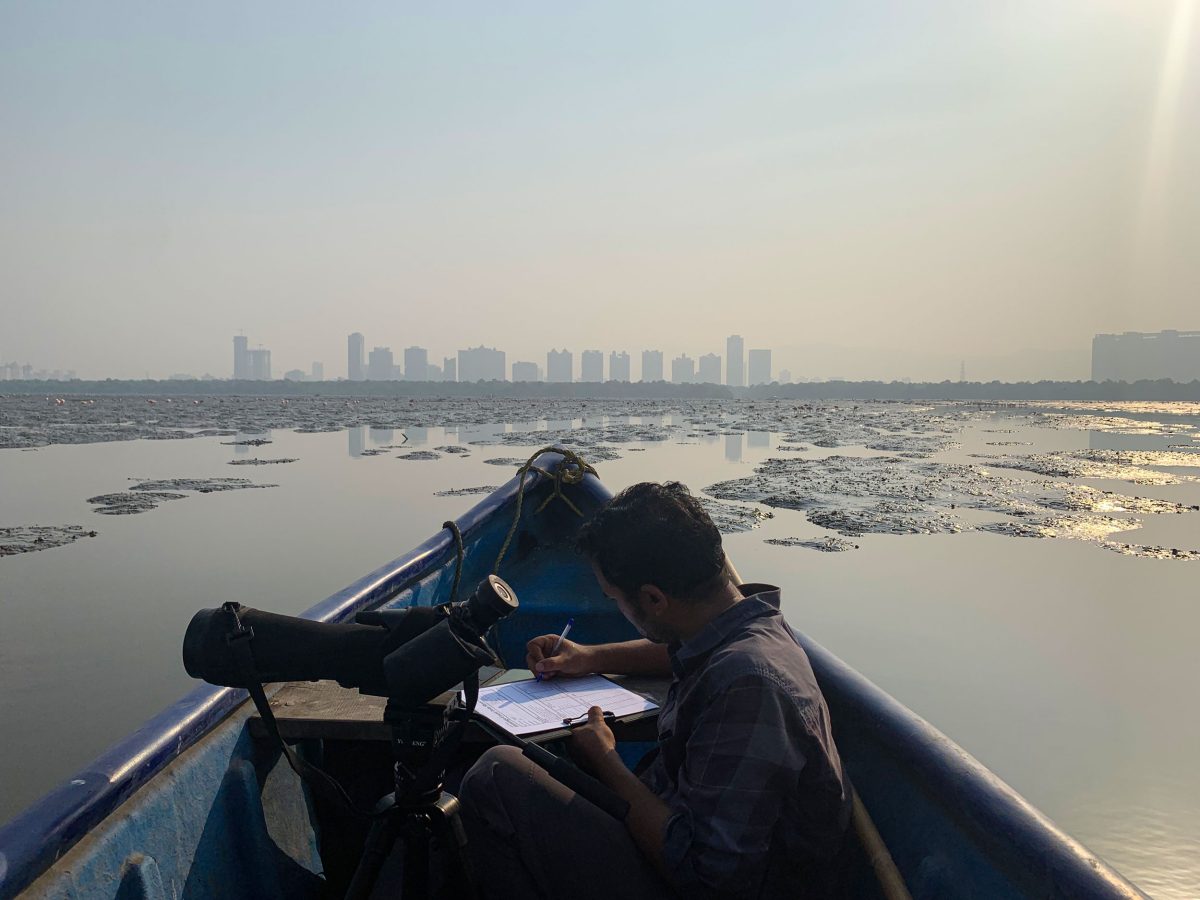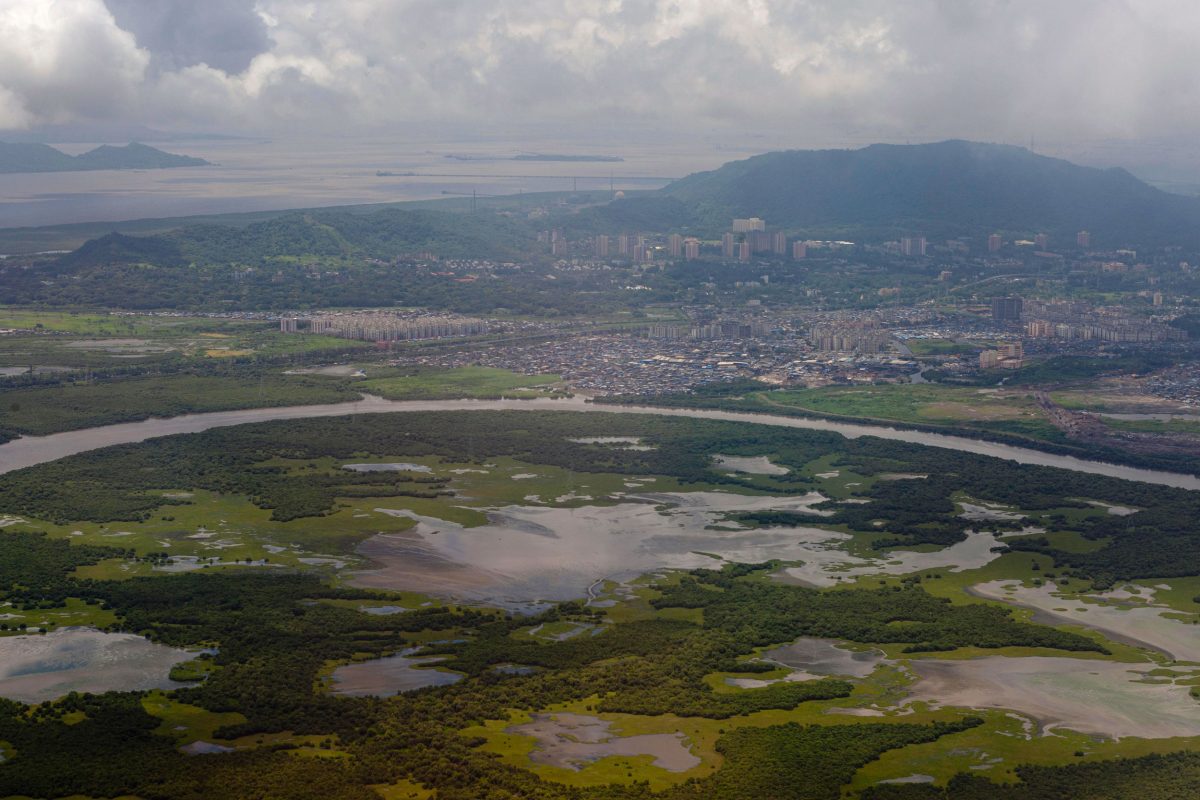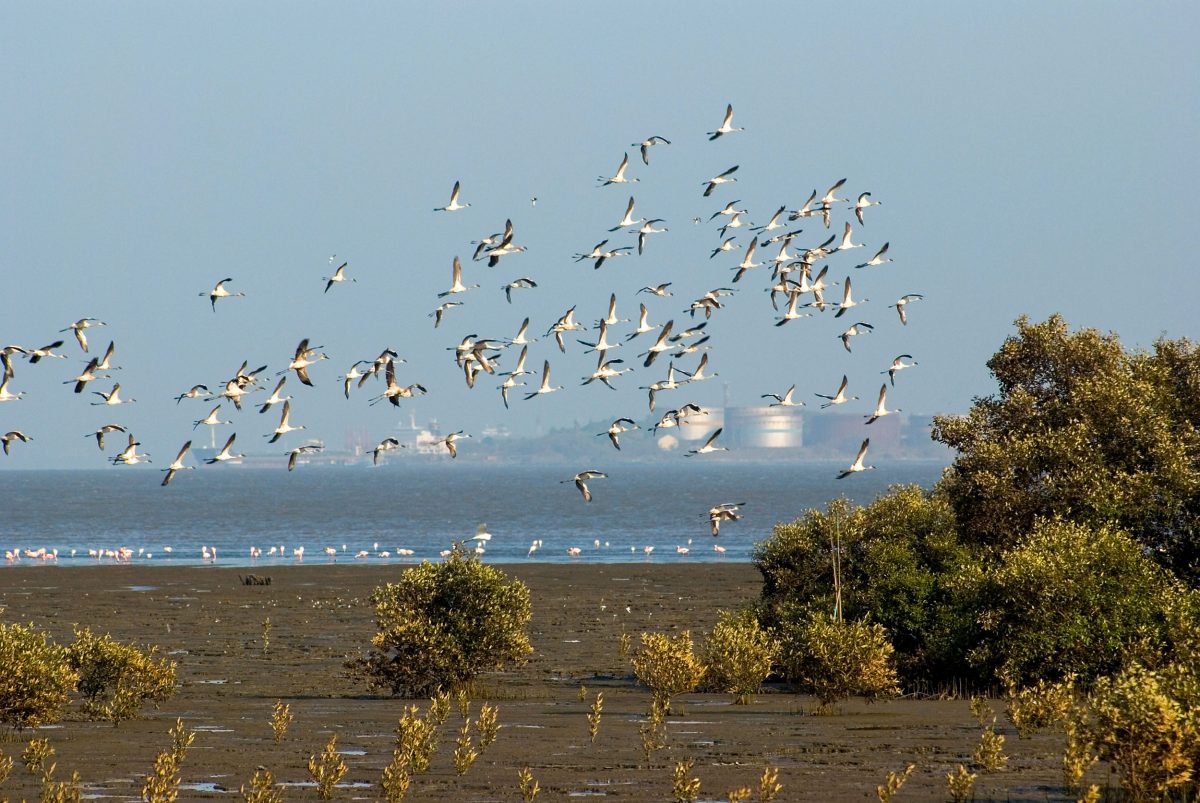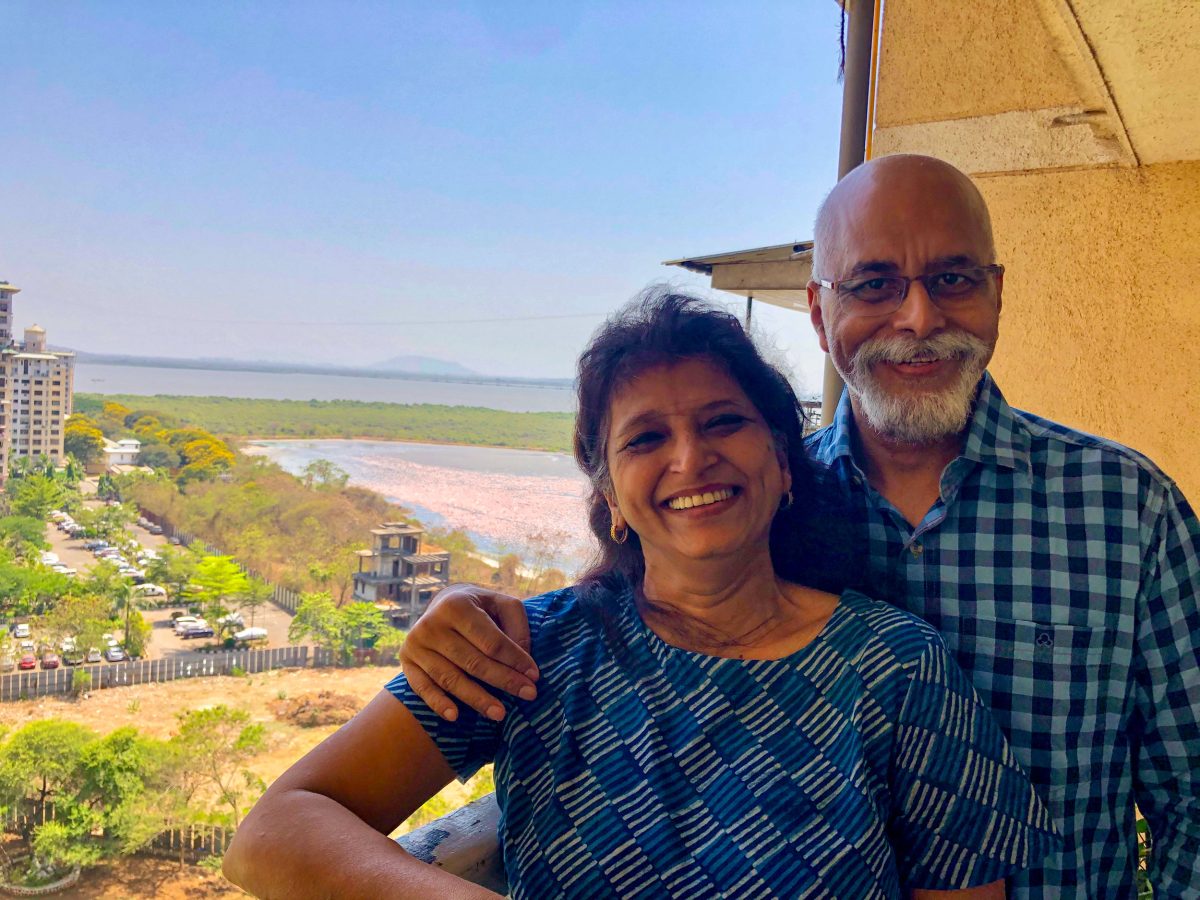Mumbai Embraces Its Booming Flamingo Population
Despite pressure from development, flamingos seem to be thriving on the shores of one of the world’s most populous cities, and local people are becoming protective of the birds and their habitat.
Article body copy
It is not yet 8:00 a.m., and the sun is already fierce on a small rowboat anchored a kilometer from the eastern banks of Thane Creek, an inlet separating the island city of Mumbai from the Indian mainland. A yellow cloth used as a reference point for scientists flutters in the line of mangroves along the shore. Behind the trees, tall buildings shimmer in a haze of pollution; in front of them, thousands of flamingos are gathering, flying in from nearby roosting sites. As the sun ascends, the tidal water in the creek’s lower reaches ebbs, exposing the mudflats that are the flamingos’ feeding grounds. The army of pink advances.
In the boat, Mrugank Prabhu unpacks his camera, sets up his telescope, and begins his count.
Prabhu is a scientist with the Bombay Natural History Society (BNHS), a 139-year-old organization involved in conservation and biodiversity research across India, which is leading an ambitious 10-year-long study to monitor a unique phenomenon. Every winter, thousands of greater and lesser flamingos fly into Mumbai, forming a sea of pink against a backdrop of skyscrapers, bridges, and oil refineries along the 26-kilometer-long Thane Creek. The seasonal gathering is a source of wonder in Mumbai, and also a bit of a mystery.

Mrugank Prabhu, a scientist with the Bombay Natural History Society, leads a study monitoring lesser and greater flamingos around the Thane Creek wetlands on the shoreline of Mumbai, India. Photo by Vaishnavi Chandrashekhar
The flamingos only began visiting Mumbai in significant numbers in the 1990s. As the city grew in the 1970s and ’80s, so did the volume of untreated sewage flowing into Thane Creek, nurturing the algae that are the flamingos’ main food and turning the area into a feeding ground for the birds. Their numbers have increased in the past two decades, from at least 10,000 in 2007 to an estimated 130,000 this year.
The phenomenon illustrates the wealth and complexity of urban coastal ecosystems in India, say experts. Sometimes, “human impact results in conditions that seem terrible for nature at a glance, but are actually a gold mine for some species,” says Sunjoy Monga, a veteran local naturalist and BNHS member who has also led a study on Mumbai wildlife. “There is so much organic richness amid the gloom [of the city].”
Now, the flamingos are reshaping the ecological mindset of the city, too, showing what wildlife can do for conservation even in the most pressured environments. Flamingos have become a source of pride for locals. In the past few years, citizens have been holding annual flamingo-themed festivals and runs to raise awareness of local wetlands. In 2018, authorities designated almost 1,700 hectares of the creek and shore as a flamingo sanctuary.
Yet threats to these remarkable birds remain, including a bridge that is under construction across the lower reaches of Thane Creek where the water spills into Mumbai Harbour. The BNHS study—the first of its duration in urban India, paid for by regional planning authorities—aims to keep a check on the impacts of the bridge construction and other developments by monitoring the abundance and biology of the flamingos and the biochemical characteristics of the creek. Now at the halfway mark, the study is unearthing some surprises. Flamingos seem to be adapting to the bridge construction for the moment—they stay 500 meters or so from the construction site—but the same environmental shifts that helped draw the birds here in the first place are changing the mudflats in ways that could jeopardize their future.
Massive flocks of greater and lesser flamingos are often associated with the saline and alkaline lakes of Kenya and Tanzania. While greater flamingos can inhabit both saltwater and freshwater habitats, lesser flamingos are found in saline waters, and the species is considered “near threatened” by the International Union for Conservation of Nature. India has the largest population of lesser flamingos outside the African continent, mostly in the salt deserts of the western state of Gujarat. There are few historical records of flamingos in Mumbai; one from 1891 suggests they were an occasional bird of passage in the region.
Today’s flocks are thought to come largely from breeding grounds in Gujarat, some 600 kilometers away. Six birds tagged with satellite trackers in March of this year migrated to that region after leaving Mumbai. Where else the birds might go will be revealed as BNHS scientists tag more flamingos in the coming years, says Prabhu.

The wetlands along the edge of Mumbai, including the 26-kilometer-long Thane Creek, provide prime feeding habitat for lesser and greater flamingos. Photo by Rakesh Dhareshwar/Alamy Stock Photo
In the meantime, thanks to leg-banding efforts by BNHS, scientists do know that some of the same birds come back to Mumbai year after year. After some flamingos discovered this fecally bolstered feeding ground, many more began coming. It’s as if they have place memory, says Prabhu.
The place, in this case, is bordered by a 400-square-kilometer port and nuclear facility to the west and high-rises and another port to the east. In between, some nature manages to thrive: an estimated 65 species of migratory birds are found in the Thane Creek mudflats, which stretch for seven square kilometers, and another 100 bird species live in the surrounding mangrove stands.
To estimate flamingo abundance, Prabhu and his team of eight sail out in their boats, using binoculars and telescopes to count birds along one-kilometer transects marked by colored flags tied to the mangroves. At the creek’s mouth, where it yawns to over several kilometers wide, the team members must row, each in their own rowboat, closer to shore just as the water is receding and the birds are arriving. This way, they can position themselves in the middle of the action, where they can get a reliable count. They wait there, marooned, for hours until the next tidal cycle.
Up close, the flamingos are no longer one mass of pink. It’s April and many of the lesser flamingos are young and still gray-white; they haven’t got their pink hue yet. The greater flamingos tower over the lesser, and although more abundant globally, are clearly fewer in number. What sounded like a cacophony of horns from a distance distills into individual calls that range from farting sounds to porcine oinks.
The birds feed relentlessly, stalking across the mudflats, beaks sweeping the ground, taking in the muddy water that will be parsed for food through their unique filtration systems. Greater flamingos feed on a variety of food including mussels, shrimp, and cyanobacteria—also known as blue-green algae—but lesser flamingos mainly eat cyanobacteria. Vast quantities of these cyanobacteria cover the Thane Creek mudflats, more than in other creeks around the state, says Reshma Pitale, a marine biologist who leads the BNHS team responsible for monitoring the water and soil along the creek. Cyanobacterial density also seems to increase after November, at the same time the flamingos start arriving.

A flock of lesser flamingos flies over the mudflats and mangroves on the Mumbai shoreline. An estimated 165 species use these habitats. Photo by Dinodia Photos/Alamy Stock Photo
The trend makes sense to Pawan K. Dadheech, a professor of microbiology at the Central University of Rajasthan and coauthor of a 2016 international study on the food of the lesser flamingo. Lesser flamingos prefer a particular type of cyanobacteria called Arthrospira, or spirulina, which requires alkaline water, he says. If Arthrospira is abundant in Thane Creek, monsoon rains would dilute the creek water, reducing its alkalinity and thus the amount of these cyanobacteria, he says. Yet, when the rains stop in September and the temperature rises, he says, “conditions will be favorable for the production of [cyano]bacteria, and especially Arthrospira.” The BNHS team’s tests should throw more light on this theory in the coming year.
It’s not just sewage-driven growth in food that’s helped attract flamingos to this area, however. Looking at satellite images of the creek, Prabhu found that mud deposition, which created the vast mudflats that host the flamingos, started increasing dramatically in the 1980s. The change was corroborated by older fishermen, who recalled being able to walk along a sandy shore for a great length of the creek in the 1970s and ’80s. The sand is gone now, replaced by mud. The mud deposition was probably due to construction debris and sewage from expanding urban development on the eastern banks washing into the creek during the monsoon, says Prabhu.
Along Thane Creek, other migratory wading birds may also have increased, although a few more years of data is needed to verify the trends, says Prabhu. Small waders are interesting, he adds, because their origin or destination is often a mystery. It’s unknown, for example, where precisely in the Arctic the little stint—an annual visitor at the creek—comes from. In June 2021, a curlew sandpiper, which breeds in Siberia, tagged here was spotted 4,500 kilometers away in Tianjin, China. In April, a common redshank that the BNHS team had banded in 2018 was spotted in Russia. The Mumbai region appears to be an important stop on the Central Asian Flyway, a migratory avian route between the Arctic and Indian Oceans, says Prabhu. Although this has likely always been the case, the study’s banding efforts—more than 15,000 birds have been tagged since 2018—should reveal more details about the birds’ migratory pathways.
Prabhu and his team will also be studying the flamingos’ breeding grounds in Gujarat in the coming year to find out if any factors are pushing them to seek food elsewhere. If there is a disturbance in the breeding habitat, is it possible that flamingos forced into Mumbai could eventually become year-round residents in the city rather than seasonal ones? That’s unlikely, suggests Prabhu, given the city’s intense monsoon and the pressures of a busy urban environment. “Breeding is a different ball game [than feeding],” he says. “[Flamingos] need a secure and secluded area with low disturbance, and lots of mud to build their mounds for nests.” With its low rainfall and remote location, the salt deserts of Gujarat provide a safer space for nesting.
In Mumbai, ironically, the mudflat habitat the flamingos depend on is now potentially threatened by excess mangrove growth, also fueled by nutrients from the sewage. Because the mangroves cannot expand landward into the city, they are growing into the creek, says Prabhu. Satellite studies show mangroves are shrinking the width of the waterway and potentially encroaching into the mudflats. Mangroves are known to be a vital shield against storm surge and sea level rise and also act as nurseries for fish; felling them was banned in the surrounding state of Maharashtra in 2018 after decades of legal battles to stem their destruction. But the ban also means that authorities at the Thane Creek Flamingo Sanctuary must now get permission from the courts to remove new growth.
Flamingos near Mumbai strain cyanobacteria out of the water on the mudflat surface. Video by GetMyStock/Shutterstock
The complexity of coastal and urban ecosystems challenges traditional understandings of conservation—including the value of sweeping rules—and highlights the importance of the BNHS study, says K. S. Gopi Sundar, a scientist with Seva Mandir, an NGO in Udaipur, India. “Urban ecosystems in India are … not well understood,” he says. Conservation approaches have often been adopted from the West or from forest management, where conditions are different, he adds. Bird diversity in Indian urban areas is often much higher than that in temperate countries, for instance. “We can’t manage our wetlands with a textbook from Europe.”
Coastal habitats are dynamic, influenced by both land and sea, adds Pitale. Soils and biodiversity in Thane Creek change upstream to downstream, tide to tide, and season to season. And if pollution has been good for the flamingos, it has been lethal for fish. The diversity of fish in the creek has crashed since the 1980s, from 22 species recorded in the early 1990s to 12 species found in a 2000 survey. The decline has been attributed to industrial pollution in earlier decades as well as the increased sewage and debris in more recent ones. Changes in the quantity and composition of mud may be changing the organisms on the mudflats, too.
In the past two years, Pitale and her team have observed a mysterious explosion of alien bivalves on the mudflats. “Will this change the community, will it outcompete other organisms?” says Pitale. “Anything can happen.”
On Earth Day, April 22, a small group of upper–middle class residents meet on a trail along a dense patch of mangroves in Navi Mumbai, the town on the eastern banks at the mouth of Thane Creek. This and nearby mangroves and shallow ponds provide roosting sites for the flamingos when high tide covers the mudflats. The residents, members of Save Navi Mumbai Environment, a citizens’ network to protect local mangroves and wetlands, introduce themselves and describe their path to environmental activism. Many of them were first moved by the destruction of greenery in their own backyards; one professional, who brought his young son along, says he got involved after losing a local pond to a development project. Another man says he and his wife traveled to Lake Nakuru in Kenya to see flamingos some years ago, unaware of their presence in his own city. “What fools we were,” he says.
After the meeting, Sunil and Shruti Agarwal, cofounders of Save Navi Mumbai Environment, take me up to their apartment, one of hundreds in the high-rises bordering the wetlands along the creek. From their 13th-floor balcony, you can see the mangroves that got them involved in environmental activism and, at high tide, the flamingos that brought others to their cause.
Soon after the Agarwals moved here in 2013, they challenged the clearance of land for a new housing project and golf course on these wetlands. Neighbors told them they couldn’t win—the project was promoted by a subsidiary of the powerful Adani Group. But in 2018, the Bombay High Court stopped the development, giving the couple their first big victory. Since then, they’ve been fighting against other development projects in nearby wetlands and raising awareness about local biodiversity. They roped in their son and daughter and their friends to help organize neighborhood festivals with games and activities for children, as well as an awareness-raising annual marathon called Run for Flamingos. At least 2,000 people participated in the event in 2020. “Nobody’s going to run for wetlands,” says the Agarwals’ daughter, Surabhi.

Shruti, left, and Sunil Agarwal, cofounders of Save Navi Mumbai Environment. Their apartment on the Mumbai coast overlooks the mangroves that are a draw for migrating flamingos. Photo courtesy of Sunil and Shruti Agarwal
Authorities at the sanctuary, which is managed by the state forestry department, are also promoting restricted tourism around the flamingos, hoping to educate the public about the birds and their habitat. Before the COVID-19 pandemic, a new marine education center and flamingo boat rides attracted some 17,000 visitors annually, including busloads of school students, says Virendra Tiwari, the senior forest officer who oversees the sanctuary. The unit has an ambitious management plan for the sanctuary that includes increased security to prevent illegal construction, a big museum on the banks of the creek, and more boats for rides—but not so many that they would disturb the birds, says Tiwari. He is hoping that the sanctuary’s recent designation as a “wetland of importance” under the international Ramsar Convention will also limit the destruction of “satellite wetlands”—the roosting sites that fall outside the 16.8-square-kilometer sanctuary but are identified in the Ramsar designation as part of a much larger 48-square-kilometer buffer zone where only “wise use” is advised.
The pandemic suspended many of the sanctuary’s activities, yet it increased flamingo fever. In the 2020 lockdown, residents of Navi Mumbai were stuck at home with nothing to do but look out their windows and see thousands of birds roosting at high tide. The flamingos made a particularly spectacular showing that year, arcing across suddenly clear skies, says Shruti. Photos and videos of the flamingos went viral, including on international media.
The flamingo is a useful totem for local ecology—but, as the Agarwals have found, it can also be reduced to an empty symbol. Late last year, the local municipality tagged Navi Mumbai as Flamingo City, putting up statues of the bird on streets and painting murals on walls. But local agencies haven’t put an end to development projects on wetlands. If the government saves the wetlands, says Shruti, “I’ll be the first to dress up as a flamingo and stand on the road.”
Out on the mudflats with Prabhu, the sun is overhead and the tide is rising. The flamingos are strutting back to the shoreline, slurping up food as they go. As the water streams in, so does the detritus of the city—packets of chips, beer bottles, medicine boxes, and the odd flip-flop. Prabhu makes his last notes, packs up his scope, and brings out the oar, ready to paddle against the strong pre-monsoon currents. His tally for the day: 15,000 flamingos in his transect alone. All around, flamingos are lifting off, stretching out like pink hockey sticks, to fly back to their roosts. Their vivid flight is almost fantastical against the haze and high-rises. Mumbai’s flamingos are an accidental marvel, an inadvertent creation at the fragile intersection of the urban and natural worlds. Can the dynamic wetland habitat, with its competing human and ecological interests, sustain these birds in the years to come? The residents of this metropolis certainly hope so. For now, the flamingos offer a flash of unexpected beauty and hope amid gray skies.

